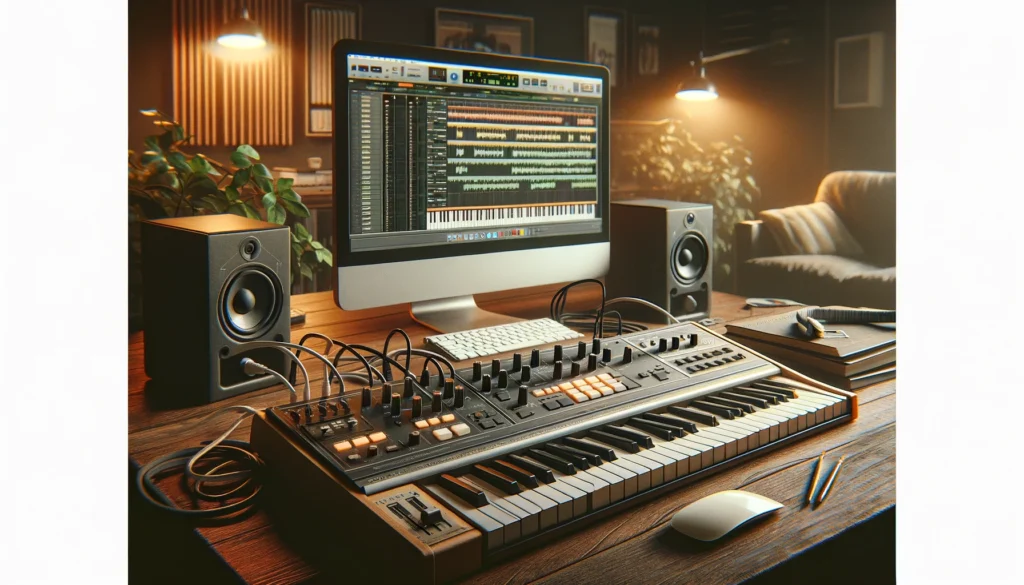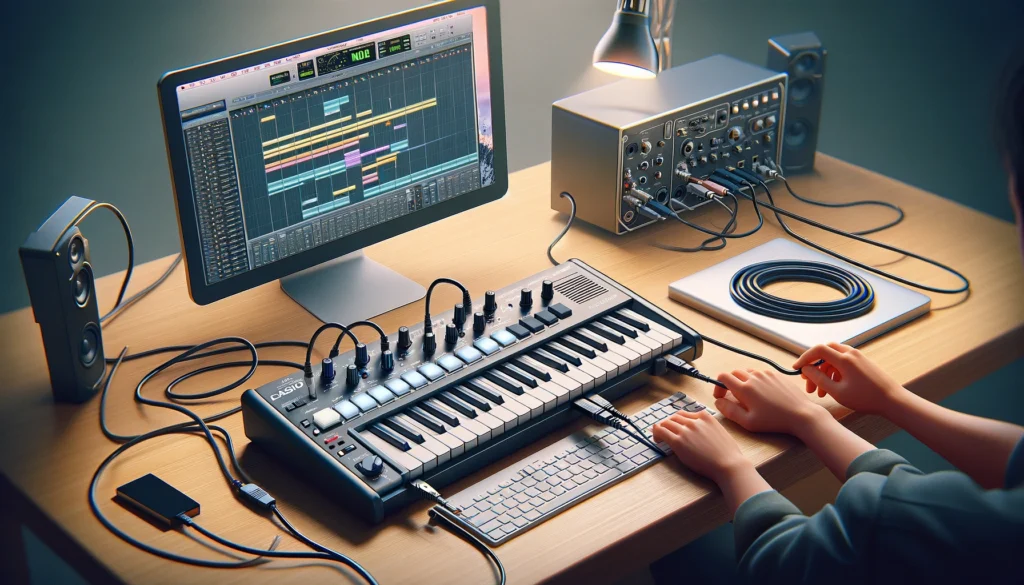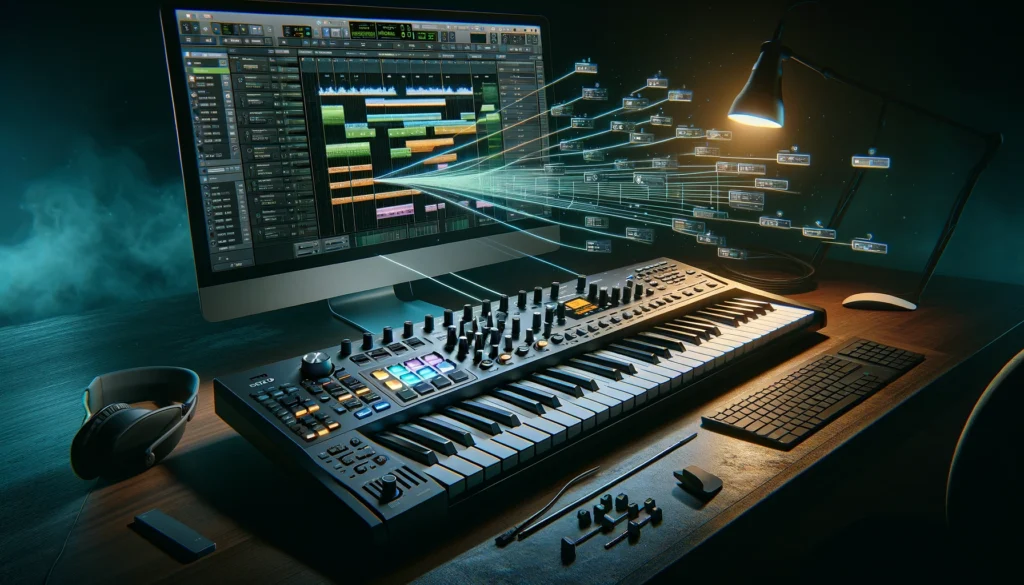Are your old Casio keyboards collecting dust? Get them making music again by hooking them up to your computer as MIDI controllers!
Using your Casio as a MIDI controller saves money since you don’t need to buy extra gear.
Let’s explore how to set up and utilize your classic Casio as a handy MIDI tool.
Title: Revive Your Vintage Casio Keyboard as a MIDI Controller
Can I Use My Casio Keyboard as a MIDI Controller?

Yes, many Casio keyboards with a 5-pin MIDI out port can interface with computers as MIDI controllers to manipulate DAW software instruments.
Now let’s get into the specifics.
What is a MIDI Controller and How Can it Be Used

A MIDI controller is a device that transmits MIDI data to control parameters and settings on software or hardware instruments.
The acronym MIDI stands for Musical Instrument Digital Interface.
It is a technical standard that allows electronic instruments, interfaces, computers and other devices to connect with each other to exchange MIDI data.
Common uses of MIDI controllers include controlling virtual software instruments loaded into a digital audio workstation (DAW), manipulating the parameters of instrument and effect plugins, changing presets and patches, automating mixing console functions and more.
Controllers allow for hands-on tweaking in real time without having to draw in data with a mouse.
This helps speed up music production workflows and also allows for musical expression during live performances with MIDI-capable hardware or software.
Determining if Your Casio Keyboard can Function as a Controller

Many Casio keyboard models going back to the mid-1990s contain a standard 5-pin MIDI out port that allows them to transmit MIDI messages to external devices including computers running music software.
Some of the most popular Casio keyboards like the CTK, WK and PX series have models with MIDI compatibility.
To determine if your particular Casio keyboard is able to function as a MIDI controller, consult the specifications in its user manual or on the official product page on Casio’s website.
Look for the mention of a built-in MIDI interface or the presence of a MIDI or MIDI/LINE OUT port.
This is typically a round 5-pin DIN connector on the rear panel of the keyboard.
Casio keyboards that support MIDI have settings in their system or global menu to configure the MIDI transmission channel as well as other communication parameters.
Access these to match them with your computer system’s settings in order to establish a proper MIDI connection.
Connecting the Casio to Your Computer
To connect your compatible Casio keyboard to your computer to use it as a MIDI controller, you will first need:
– A standard 5-pin MIDI cable, usually 6 feet or less in length
– A MIDI interface like a basic USB-MIDI adapter cable for computers without dedicated MIDI ports
Connect the MIDI out port on the Casio keyboard to the MIDI in port on the interface (i.e.
MIDI interface or USB-MIDI adapter).
If using a direct USB-MIDI adapter, simply plug it into a USB port on the computer.
For setup, both the keyboard’s MIDI transmit channel (set in the MIDI settings menu) and the channel used to receive the MIDI notes and controller data in your music software need to match.
They both default to channel 1 in most cases.
Without proper matching of the channels, the keyboard will not be able to communicate with the software properly.
Using the Casio as a MIDI Controller

Once connected, a compatible Casio keyboard with MIDI capability can be used to transmit note data as well control performance parameters.
This allows you to leverage the Casio keyboard as a MIDI controller for creative music production or live performance applications.
For example, the keys, pads and buttons can be mapped to trigger virtual instrument notes or clips.
The keyboard zones or splits could be used to separately play bass and lead parts or layered synth and organ sounds.
The built-in pitch bend wheel, modulation wheel and panel knobs and sliders can be assigned to manipulate software instrument filters, attack, release, vibrato and many other parameters in real time.
This enables expressive playing and dynamic sound shaping.
You also have transport controls like play, stop, record at your fingertips to control the overall DAW or sequencer functions.
This facilitates quick workflow for punch ins/outs or rolling record takes without having to grab the mouse.
Configuring Keyboard Zones, Splits, Layers
Most Casio keyboards have settings to configure key zones, splits and layers which can be useful for MIDI controller implementation.
For example, accessing the split mode allows you to divide the keyboard at a specific key – say middle C.
This effectively gives you two independent zones – the keys below middle C could be assigned to play bass notes while the upper keys play lead lines.
Layer mode allows stacking two sounds together across the entire keyboard range.
You could layer pianos and strings this way.
Then by setting each sound to its own MIDI channel, you can independently control their parameters.
Using zones, you may decide to reserve the Casio’s top two octaves for synths, the middle for organs and the lower for playing basslines.
This provides more flexibility within a song to cover multiple parts.
Assigning Parameters to Knobs, Sliders and Wheels
Beyond transmitting MIDI note data, a Casio keyboard controller opens up hands-on control of various parameters for shaping sound in real time.
The pitch bend wheel can be assigned to bend the pitch or as a general mod wheel for applying vibrato or other effects.
The built-in knobs, buttons and sliders can be mapped to filter cutoffs, attack and release stages, chorus/flange depth etc.
This allows you to dynamically tweak the sound during a performance to create interest and variety as you play.
For music production, it facilitates quick experimentation with instrument voices to find appealing sounds without having to draw in automation data.
Limitations and Issues to Be Aware of

While Casio’s MIDI-equipped keyboards provide flexibility as MIDI controllers to manipulate software instruments and DAW functions, they do have some limitations compared to more advanced and full-featured hardware controllers.
The biggest constraint is the number of physical buttons, knobs and sliders available to assign parameters to.
More sophisticated controllers from brands like Native Instruments or Akai for example, tend to have twice as many (if not more) physical controls.
This allows control over a wider range of parameters simultaneously.
Casio keyboards also lack any form of display or visual feedback to indicate Names and values of parameters getting tweaked in real time.
latency could also pose a problem – this is the slight delay between pressing a key or moving a knob, and hearing the sound come through the software instrument as a result.
Fine adjustments to buffer settings helps minimize latency but rarely achieves the imperceptible levels of dedicated audio interfaces.
Finally, Casio keyboards don’t offer deeper customization or MIDI mapping capabilities compared to more advanced controllers designed specifically for music production vs just recreational playing.
Conclusion
While limited in some aspects compared to dedicated production gear, Casio keyboards with MIDI capability can still serve as flexible and cost-effective MIDI controllers to play virtual instruments as well as manipulate their parameters in real time.
Their built-in wheels, buttons and knobs facilitate hands-on sound design experimentation and allow for musical expression during live playing or recording.
With some optimization of zones, splits and MIDI assignments tailored to your production needs, a Casio MIDI keyboard provides added convenience and control.
